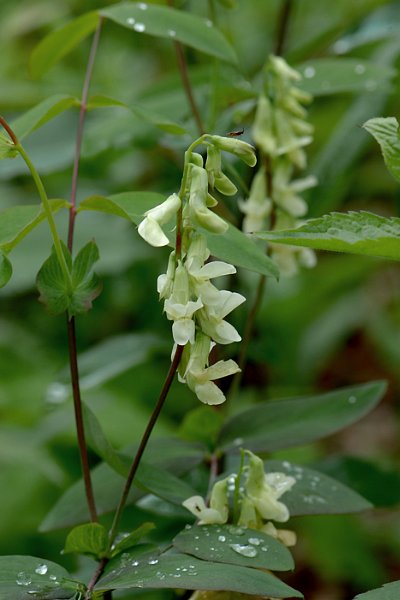Description: This perennial herbaceous wildflower is 1-3' tall and semi-erect to erect in habit. Its stems are light green to purplish brown, angular or terete, glabrous, and sometimes glaucous. Alternate compound leaves occur along these stems at intervals; they are widely spreading to ascending and evenly pinnate. Each compound leaf consists of 4-10 pairs of leaflets along a rachis (central stalk) that is light green to purplish brown and glabrous. The tip of each compound leaf terminates in a branched tendril that can cling to adjacent vegetation, fences, and other objects.

Individual
leaflets are 1-2" long and ½-1¼" across; they are
oval-ovate in shape, smooth along their margins, and glabrous. The
upper leaflet surface is medium green, while the lower surface is pale
green. Each leaflet has a short narrow petiole at its base that
connects to the rachis of the compound leaf. Where each compound leaf
joins the stem, there is a pair of leafy stipules about ½-1" in length.
Each stipule is half-cordate in shape, forming a rounded basal lobe,
where there are 1-3 small secondary lobes with blunt tips. Narrow
racemes of 5-12 flowers (about 2½-5" in length) are borne on long naked
peduncles that are shorter than the compound leaves. Individual flowers
are ½-¾" long, consisting of 5 white or cream-colored petals, a light
green to nearly white tubular calyx with 5 teeth, several hidden
stamens, and a pistil with a single style. Each flower has a
typical
pea-like floral structure, where one upper petal forms the banner (or
standard), 2 lateral petals form the wings, and 2 petals form the keel
that is enclosed by the wings. The pedicels of the flowers
are short
and narrow. The blooming period occurs from late spring to mid-summer.
Each flower is replaced by a 2-valved seedpod that becomes 2-3" long at
maturity. Each seedpod is cylindrical, somewhat flattened, and
glabrous, tapering at its tip into a curved beak. When they are fully
mature, the seedpods divide into 2 parts to release their seeds. The
root system is fibrous and rhizomatous.
Cultivation:
The preference is partial sun, moist to dry conditions, sandy or rocky
soil with some organic matter, and relatively cool temperatures during
the summer.
Range & Habitat:
Pale Vetchling is native to Illinois, where it is uncommon and
state-listed as 'threatened.' It is found primarily in northern
Illinois, although there are a few isolated populations in the southern
part of the state. This wildflower is more common in areas lying north
of the state. Habitats include upland woodlands, upland savannas, sandy
bluffs, wooded slopes, the slopes of rocky ravines, and riverbanks. In
Illinois, Pale Vetchling often occurs where oak trees are dominant.
Faunal Associations:
The flowers are pollinated by bumblebees and other long-tongued bees,
where they seek nectar and pollen. The caterpillars of the butterfly Glaucopsyche
lygdamus (Silvery Blue) sometimes feed on vetchlings (Lathyrus
spp.), although they are more often found on Vetches (Vicia
spp.); this insect has a boreal range that is similar to Pale
Vetchling. An aphid, Nearctaphis
crataegifoliae, and other aphids may feed on this
plant as well. The Ruffed Grouse sometimes eats the seeds and foliage
of vetchlings.
Photographic Location:
A woodland in NE Illinois. The photograph was taken by Tobin Fraley
(Copyright © 2010).
Comments:
Pale Vetchling is one of several Lathyrus spp.
(vetchlings) in Illinois. Sometimes it is referred to as 'Cream Pea' or
'Cream Peavine.' This species can be distinguished from others in this
genus by its white or cream-colored flowers, relatively broad leaflets,
and distinctive stipules, which have rounded basal lobes with one or
more secondary lobes. Other species in this genus often have
purple-lavender flowers, narrow leaflets (less than one-third as wide
as long), and their stipules lack secondary lobes. Pale Vetchling would
probably be adaptable to cultivation in partially shaded gardens.